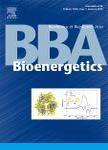版权所有:内蒙古大学图书馆 技术提供:维普资讯• 智图
内蒙古自治区呼和浩特市赛罕区大学西街235号 邮编: 010021

作者机构:RENSSELAER POLYTECH INST TROY NY 12181 USA
出 版 物:《BIOCHIMICA ET BIOPHYSICA ACTA》 (Biochim. Biophys. Acta Bioenerg.)
年 卷 期:1984年第767卷第2期
页 面:263-271页
核心收录:
学科分类:0710[理学-生物学] 071010[理学-生物化学与分子生物学] 07[理学]
基 金:NATIONAL INSTITUTE OF GENERAL MEDICAL SCIENCES [R01GM026133] Funding Source: NIH RePORTER NIGMS NIH HHS [2RO1 GM26133-04] Funding Source: Medline
主 题:Photosystem II ESR Linolenic acid Quinone Electron transport (Spinach chloroplast) F i initial fluorescence yield F max maximum fluorescence yield F var variable fluorescence yield Ph pheophytin intermediate electron acceptor Q A primary quinone acceptor Q B secondary quinone acceptor Z secondary electron donor Mes 4-morpholineethanesulfonic acid DCMU 3-(3′,4′-dichlorophenyl)-1,1′-dimethylurea Tricine N -[2-hydroxy-1,1-bis(hydroxymethyl)ethyl]glycine TSF-II Triton Photosystem-II particles
摘 要:Time-resolved spectroscopic techniques, including optical flash photolysis and ESR spectroscopy, have been utilized to monitor electron-transport activity in Photosystem II subchloroplast [spinach] particles. In the presence of 100 .mu.M linolenic acid a high initial fluorescence yield (Fi) is observed upon steady-state illumination of the dark-adapted sample;flash-induced absorption transients (t 10 .mu.s) in the region of 820 nm, attributed to P-680+, are first slowed, then abolished;and ESR Signal IIs and Signal IIf (Z+) are not detectable. Upon reversal of linolenic acid inhibition by washing with bovine serum albumin, optical and ESR transients originating from the photooxidation of P-680 are restored. Similarly, the variable component of fluorescence is recovered with an accompanying restoration of Signal IIs and Signal IIf. Linolenic acid apparenty affects 2 inhibition sites in Photosystem II: one located between pheophytin and QA on the reducing side, and the other between electron donor Z and P-680 on the oxidizing side. Since both sites are associated with bound quinone molecules, linolenic acid probably interacts at the level of quinone binding proteins in Photosystem II.